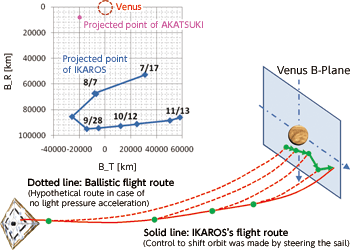TOP > Report & Column > The Forefront of Space Science > 2011 > Solar Sail Navigation Technology of IKAROS
![]()

Manipulating IKAROS's orbit Now let me move to the main topic - navigation and guidance of the solar sail. IKAROS's navigation and guidance task is roughly divided into two parts ? orbit determination and orbit control. One problem in orbit determination for the solar sail is that it has to be implemented under constant minute perturbations caused by light pressure. Even with HAYABUSA, orbit determination during minute thrust conditions was difficult. We needed to implement the task as a routine operation with IKAROS. If we were able to estimate the perturbation accurately, however, we could evaluate the sail condition in orbit, i.e., "the solar-sail performance." A research group was launched within the IKAROS team to conduct the evaluation. With the participation of many postdoctoral fellows and students as well as JAXA staff and external companies, we were able to complete the analysis using flight data. With this orbit-determination technology, a thin beam from the 64m antenna at Usuda has been able to track IKAROS constantly. Currently, we are trying to draw out more detailed information on sail performance by estimating optical parameters, which are higher order than the usual orbit determination. Orbital control for the solar sail means attitude control stated above. Specifically, the task is to control the sail direction to the Sun daily so that IKAROS may fly along the given target orbit. IKAROS is a mission that has no predetermined destination. The orbit was designed to optimize the AKATSUKI mission, which was co-launched with IKAROS. For this reason, we set up a tentative target on the collision cross-section (technically known as the B-plane) including Venus and have evaluated the guidance performance by guiding IKAROS to the target (Fig. 4). In other words, we set a provisional point situated at the same distance as Venus and flew IKAROS towards that point. Thus, we were able to fly IKAROS, which was initially inserted to about the same orbit as AKATSUKI by the H-IIA rocket, to pass the opposite side of AKATSUKI across Venus (i.e., the night side of Venus). We are still evaluating the guidance and navigation performance in detail. Nevertheless, the IKAROS team is confident that it has obtained the solar-sailing technology. 
Conclusion IKAROS acquired acceleration of 100m/s from the solar-light pressure over six months until it passed Venus. This value is equal to propellant amount consumed for orbital adjustment of deep-space exploration missions of usual ballistic flight. Moreover, the advantage is simply proportional to flight duration. Our next technical target is a sail area 10 times that of IKAROS and mission duration over five years. This translates to an acceleration capability of several km/s, which is virtually the same as obtaining rocket acceleration capability without fuel. Furthermore, by using the large sail as a generator, we plan to drive an electric propulsion system with high-specific impulse and high power, eventually add more freedom to mission planning. I hope that you see how solar-power sail technology can drastically change deep-space exploration in the future. Yuichi TSUDA
|
||||||




